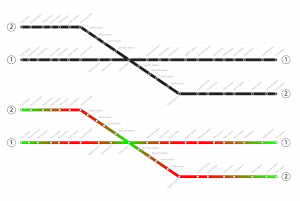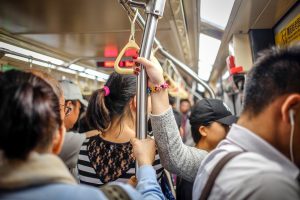Exploring the Exclusionary Aspects of the Commute Behavior of Subway Riders | Morteza Farhoudi
Imagine yourself being a citizen of a large city, relying on public transport for commuting between home and workplace. If your home/workplace is located anywhere other than the proximity of the first few stations of a line—or to some extent, intersection of two lines—the chances are rare that you can have a seat during your ridership (i.e., because usually there are more people than there are space and seats, and the seats are already occupied by those who have taken the train in its first stations). The following schematic subway map—with two intersecting lines—represents this phenomenon. The green-red color-coded version of the map shows that those who take the train in the green areas tend to have the privilege of seating and occupying the most desired spaces.

This issue shows that from an inclusivity perspective, the interior space of subway cars is unintentionally exclusionary towards a considerable number of commuters. And this is just the beginning of a chain of issues that affect the quality of commuters life. Such—apparently inconsequential—issues could be among the reasons that make commuting a stressful experience (Bhat & Sardesai, 2006; Tse et al., 2006). And as shown by Wener et al. (2005), this stress can spill over into commuters’ work and home life, affecting the overall quality of their life (Costal et al., 1988).
Commuting experience, as a transitory stage in commuters’ daily life, has been of peripheral concern for mobility scholars. The aim of my MRP is to explore the possibilities for making commuting experience by public transit less stressful, particularly by making it more equitable.
Following video is a short introduction to my MRP; introducing the problem, outlining the objectives and the expected outcomes:
https://youtu.be/FubShu_3ars


